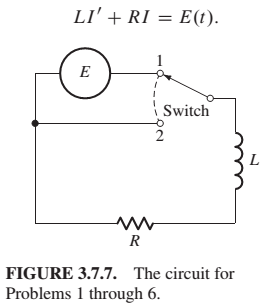
Problems 1 through 6 deal with the RL circuit of Fig. 3.7.7, a series circuit containing an inductor with an inductance of L henries, a resistor with a resistance of R ohms, and a source of electromotive force (emf), but no capacitor In this case Eq. (2) reduces to the linear first-order equation FIGURE 3.7.7. The circuit for Problems 1 through 6.

In the circuit of Fig. 3.7.7, with the switch in position 1, take
Want to see the full answer?
Check out a sample textbook solution
Chapter 3 Solutions
Differential Equations: Computing and Modeling (5th Edition), Edwards, Penney & Calvis
Additional Engineering Textbook Solutions
Starting out with Visual C# (4th Edition)
Artificial Intelligence: A Modern Approach
Absolute Java (6th Edition)
Starting Out with Programming Logic and Design (5th Edition) (What's New in Computer Science)
Starting Out with Java: From Control Structures through Data Structures (4th Edition) (What's New in Computer Science)
- As an OCTAVE pogram: A 1 kg mass is rests on a frictionless 1 meter long ramp and compresses a k = 4000 N/m spring a distance of 5 cm. The ramps angle of incline varies from 10 to 50 degrees, in increments of 10 degrees. For each angle of incline, determine if the block will slide off the top end of the ramp after it is released from the Spring. Output each angle of incline and whether of not the block reaches the top of the ramp.arrow_forwardWhat logic function is performed by the circuit of Fig. 1.1?arrow_forwardState the generalized pigeonhole principle.arrow_forward
- where is it demonstrated that the Hamiltonian circuit's tour length is, at most, 4/3 times that of the ideal TSP trip.arrow_forward0.05 kg of steam at 5 bar is contained in a rigid vessel of volume 0.0076m3 . What is the temperature of the steam? If the vessel is cooled, at what temperature will the steam be just dry saturated? Cooling is contained until the pressure in the vessel is 11 bar, determine the final dryness fraction of the steam, and the heat rejected between the initial and the final states.arrow_forwardConsider an aluminum single crystal under a stress state σx =250 psi, σy =−50 psi, σz =τyz =τzx =τxy =0, where x=[100], y=[010], and z=[001]. A. Whatistheresolvedshearstress,τnd,onthe(111)planeinthe[110]direction? that is, with n=[111], d=[110]? B. What is the resolved shear stress on the (111) plane in the [101] direction?arrow_forward
- From the following function : G = A + B (A+C) + AC Use the theorem of boolean algebra and obtain the reduction of the function, then draw the diagram of that function.arrow_forward19. Determine an Euler circuit from the graph below. Give only one.arrow_forwardQ.5/ How to change the frequency of oscillation of the following circuit to 10kHz?arrow_forward
- 5. Determine the range of K for stability of the following characteristic equation, ©s(E2+s+D(s+4H)+K=0arrow_forwardAir at 30 oC flowing over a flat plate 10 points 0.5 m long and 0.6 m wide, is to be maintained at 70 oC . Determine the velocity of air which must flow over a side of 0.5m. The rate of energy dissipation from the plate is 3 KW.arrow_forward2. Heat conduction in a square plate Three sides of a rectangular plate (@ = 5 m, b = 4 m) are kept at a temperature of 0 C and one side is kept at a temperature C, as shown in the figure. Determine and plot the ; temperature distribution T(x, y) in the plate. The temperature distribution, T(x, y) in the plate can be determined by solving the two-dimensional heat equation. For the given boundary conditions T(x, y) can be expressed analytically by a Fourier series (Erwin Kreyszig, Advanced Engineering Mathematics, John Wiley and Sons, 1993):arrow_forward
 Operations Research : Applications and AlgorithmsComputer ScienceISBN:9780534380588Author:Wayne L. WinstonPublisher:Brooks Cole
Operations Research : Applications and AlgorithmsComputer ScienceISBN:9780534380588Author:Wayne L. WinstonPublisher:Brooks Cole C++ for Engineers and ScientistsComputer ScienceISBN:9781133187844Author:Bronson, Gary J.Publisher:Course Technology Ptr
C++ for Engineers and ScientistsComputer ScienceISBN:9781133187844Author:Bronson, Gary J.Publisher:Course Technology Ptr

